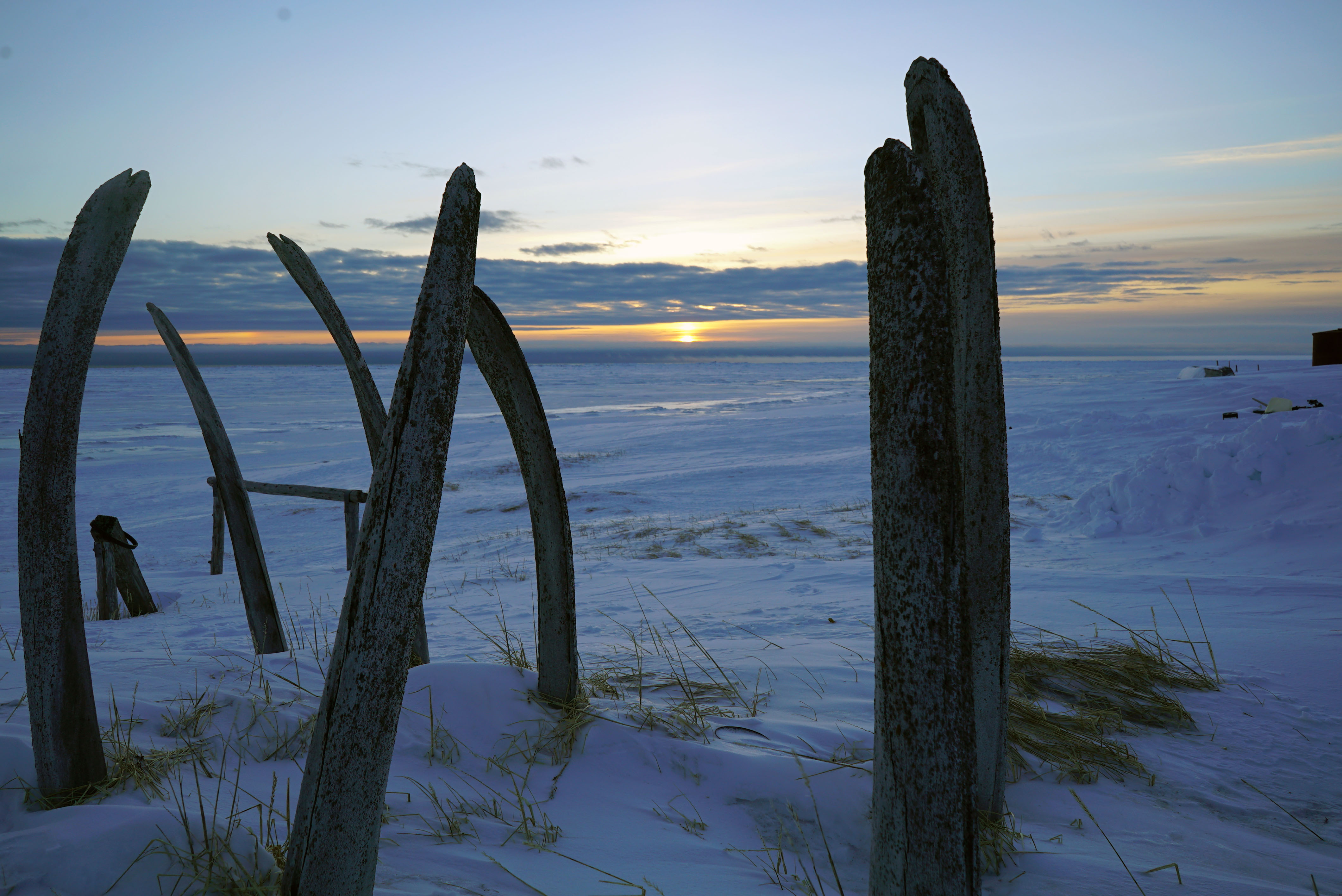WALES, Alaska — The single-engine Cessna buzzes back down the gravel runway, clouds of snow swirling in its wake as it pops into the air, climbs aloft and circles around.
Silence again descends upon one of the most remote villages in the United States.
Life is hard here. People and animals struggle to stay warm, to find shelter, to eat. The relentless wind scours the snow, whipping flakes into unprotected eyes. Extremely bad weather often means there’s no connection with the outside world for days at a time.
But the Internet usually works. And there’s fresh salad if you’re willing to pay the freight charge.
![Ice melt forces polar bears into paths of Alaska schoolchildren [oembed : 83384236] [oembed : 83384236] [oembed : 83384236] [oembed : 83384236] [oembed : 83384236] [oembed : 83384236] [oembed : 83384236] [oembed : 83384236] [oembed : 83384236] [oembed : 83384236]](/Portals/_default/Skins/PrestoLegacy/CommonCss/images/smartembed.png)
Welcome to the westernmost town on the mainland United States, where native Inupiat traditions are increasingly clashing with the modern world, where schoolchildren watch LOL videos on YouTube but also learn to make kuspuks, traditional coverings for parkas.
“Looking back it’s just like you’re in a movie but living it,” says Clyde Oxereok, 57.
A ninth-generation native of Wales, Oxereok has left Alaska twice: first on a high school trip to California, and again to attend basic training in Georgia. During the Cold War, Oxereok and other family members served in the Alaska Army National Guard in Wales, providing surveillance across the strait that polar bears today routinely cross. A Russian island is just 18 miles away; mainland Siberia is 50 miles off the coast.
Stepping from the plane into Wales feels a lot like stepping back in time, albeit with caveats. Most people lack running water inside their homes, which means they use “honey buckets” for toilets, carrying them outside to be emptied into a disposal lagoon. Hunters like Oxereok eat bowhead whale, walrus oil and reindeer. His trigger finger gets itchy whenever he sees a seal swimming in the icy ocean.
HELICOPTER LIFELINE
On the other hand, as many as six planes a day land at that gravel airstrip, carrying in basically anything Amazon sells and you're willing to pay for. That air lifeline is tenuous, though, and frays fast when the weather is bad.
“Last year we ran out of toilet paper in the entire village. We didn’t see a helicopter for six weeks,” says Michael Potter, a teacher on the nearby island of Little Diomede, which is actually even closer to Russia than Wales.
![Sometimes the school bus is a helicopter [video : 83342286]](http://videos.usatoday.net/Brightcove2/29906170001/2016/04/29906170001_4855816333001_4855779151001-vs.jpg?pubId=29906170001)
Students from Little Diomede last week were helicoptered into Wales for a basketball tournament. They stayed in Wales for a few days, sleeping in high school classrooms while they attended classes and awaited their ride back.
“People don’t understand – this is not like going to the zoo or going to a camping trip into the Sierras,” Potter say. "Out here, it’s truly life and death. It’s not for the faint of heart. If you don’t look out for each other, people freeze to death.”
YOUTUBE AND WHALE HUNTS
The Inupiat culture is based around shared values, and in Wales, extended families remain close. Oxereok’s older brother often jokes that a kid misbehaving on one side of the tiny village will have angry and well-informed parents waiting at home.
Oxereok says technology is forcing the culture to change, and perhaps faster than anyone realizes.
“You have to earn money to buy a cell phone, to pay the electric bill. People are more on a time constraint than when I was a kid,” he says. "In the last 10 years you could really see technology leap into our village.”
And technology is everywhere. Most adults and kids carry cell phones. Parents joke about how Facebook keeps them connected with the community, even though they live amidst it. Kids watch cat videos on YouTube in the school library among stacks of books about the traditional Inupiat lifestyle.
![Ninth-generation resident of the westernmost town in mainland U.S. by USA TODAY News [oembed : 83374838] [oembed : 83374838] [oembed : 83374838] [oembed : 83374838] [oembed : 83374838] [oembed : 83374838] [oembed : 83374838] [oembed : 83374838] [oembed : 83374838] [oembed : 83374838] [oembed : 83374838] [oembed : 83374838] [oembed : 83374838] [oembed : 83374838] [oembed : 83374838] [oembed : 83374838] [oembed : 83374838] [oembed : 83374838] [oembed : 83374838] [oembed : 83374838]](/Portals/_default/Skins/PrestoLegacy/CommonCss/images/smartembed.png)
Terrin Magby, 26, was born on Little Diomede and grew up in Wales, but lived the past eight years in Anchorage. He returned to Wales for the lifestyle he thought he'd left behind, and for work, repairs snowmobiles and transports honey buckets to the lagoon.
He’s hoping to go on his first whale hunt this spring. As the greenest member of the crew, he says he’ll likely be stuck lighting cigarettes and handing sodas to the more experienced men.
The young men of the village smile as they eagerly await the first whale hunt of the season. The Bering Strait is a choke-point between the Pacific and the Arctic, which means massive numbers of whales, seals, fish and birds flood through with the changing seasons.
“I’m still trying to make my transition. It’s hard going being back from being a city boy to in the village. As a kid, you’re stuck here. This was all we knew,” said Magby, who’s never left Alaska.
Still, he says, he wouldn’t have it any other way.
Why?
“The country. Just the country. That’s the easiest answer. I can get out and go anywhere I want to,” he said. “In Anchorage, I had to go to work every day. Here, there is no schedule.”


![635968506792592186--28-Wales.JPG [image : 83350716]](http://www.gannett-cdn.com/-mm-/257716b2af324ce7e81e6a9cbd2bde99b32dc7b3/c=901-713-2082-1722/local/-/media/2016/04/21/USATODAY/USATODAY/635968506792592186--28-Wales.JPG)
![635968506773248062--07-Wales.JPG [image : 83350690]](http://www.gannett-cdn.com/-mm-/dd63a3ac7809a32da97b90437d944914ebb1face/c=463-0-3776-2832/local/-/media/2016/04/21/USATODAY/USATODAY/635968506773248062--07-Wales.JPG)
![635968506792904188--32-Wales.JPG [image : 83350728]](http://www.gannett-cdn.com/-mm-/7e52b5f342823b49e087a38716d9b77bfc4685ae/c=0-0-3313-2832/local/-/media/2016/04/21/USATODAY/USATODAY/635968506792904188--32-Wales.JPG)
![635968506773092061--11-Wales.JPG [image : 83350698]](http://www.gannett-cdn.com/-mm-/70c33649506181b2b72f0953a77248fcdca53bce/c=1896-432-3580-1871/local/-/media/2016/04/21/USATODAY/USATODAY/635968506773092061--11-Wales.JPG)
![Life on the edge of America: Scenes from the village of Wales, Alaska [gallery : 83349490]](http://www.gannett-cdn.com/-mm-/dd63a3ac7809a32da97b90437d944914ebb1face/c=463-0-3776-2832/local/-/media/2016/04/21/USATODAY/USATODAY/635968506797116215--37-Wales.JPG)
